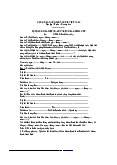



















Preview text:
WHITE PAPER
Morgan Lovell Inspiring office transformation SUSTAINABLE OFFICE DESIGN
UNLOCKING PERFORMANCE & PRODUCTIVITY
Sustainable design is an exciting area of architecture and building which
is moving into the mainstream. And there’s a good reason that ‘green’ or
sustainable buildings are also known as ‘high performance buildings’: they
not only tend to save on running costs, there is also growing evidence that
they can increase productivity and well-being for occupants through improved lighting and air quality. By Beatrice K. Otto
Where office buildings have been designed or refurbished to be more sustainable,
productivity gains in terms of better quality of work and reduced absenteeism can Beatrice Otto has written a
often dwarf the reductions in energy bills. Refits which are more sustainable can number of reports and papers
on sustainable business, design therefore yield faster returns on investment than is commonly expected. and architecture, as well as having worked on a range of
related projects in Europe and WHAT WE WILL COvER
China. She currently works for the World Business Council
SUSTAINABLE DESIGN & BUILDINGS for Sustainable Development WHAT ARE THE BENEFITS? (WBCSD); the views in this HOW DO I BEGIN? paper are her own and do not WHAT SHOULD I LOOK FOR? represent the WBCSD. ENERGY AIR LIGHT WATER MATERIALS FURNITURE GOvERNMENT RESPONSES OvERvIEW OF SUSTAINABILITY WHERE CAN I SURF MORE? WHERE CAN I DIG DEEPER?
WHAT DOES IT ALL MEAN? GLOSSARY 1 SUSTAINABLE OFFICE DESIGN
T 0800 028 0945 W morganlovell.com WHITE PAPER
Morgan Lovell Inspiring office transformation
SUSTAINABLE DESIGN & BUILDINGS WHAT’S IT ALL ABOUT?
“Technology and the growth of computers allows you a much freer palette
as an architect. Also, the study of nature and the way plants grow is more
and more available. Bring these things together and there is quite a strong
human response. Combine with a better understanding of materials,
then we are in for a much richer phase of architecture.” Nick Grimshaw People & planet
Sustainable design creates products, places, processes and systems which optimise
human well-being now and in the future without compromising the well-being of the planet.
Architecture is one of the most exciting, visible and burgeoning areas for sustainable
design with a rich array of techniques, systems, technologies and materials already
in place that can drastically reduce the effects buildings have on the environment while
bringing about a step change in comfort and efficiency. Buildings can be self sufficient
in energy, purifying their own air, and treating at least some of their own waste.
Performance & productivity
Sustainable office design can deliver higher performance in energy and other resource
use, and higher productivity in human terms. People simply work, see and think better
in offices that have more natural lighting, fresher and cleaner air, and where they have
more control over their immediate lighting or temperature levels. At a practical level,
it simultaneously minimises the: • number • amount • volume • weight • toxicity
• and use of materials, energy and water
while maximising the use of materials, energy and other components that are: • clean and safe • renewable
• easy to repair, reuse, recycle or refurbish
• and benign towards the environment 2 SUSTAINABLE OFFICE DESIGN
T 0800 028 0945 W morganlovell.com WHITE PAPER
Morgan Lovell Inspiring office transformation FIRST PRINCIPLES
Health, wealth and happiness
Optimising well-being involves thinking about the personal, physical, social, cultural
and economic effects of buildings. Hospitals can consider the curative effects of
light, colour, and air quality on human health and spirit. Residential and public
buildings can reduce crime and social isolation or disaffection. Schools can improve
the concentration and commitment of pupils by responding to their human needs.
Workplaces can enhance productivity by designing with occupants in mind. Slow the flow
Currently, materials tend to flow down a one-way street. We extract, process, use,
throw away. Most things we use (including buildings) come with serious baggage in
energy, materials and emissions. By using materials that have been reclaimed or
recycled, and by designing for durability and adaptability (the two go hand in hand), we
can slow the flow, ideally to a trickle. Reduce the use
“We can reduce our energy
Water, energy, materials, components. Find ways to lighten your footprint and use by 80 percent with
lightweight materials. For example, you could use a lighter material, or consider no reduction in our
lightweight structures that retain strength but reduce material density: particleboard quality of life.”’
with a honeycomb structure has a high strength to weight ratio: metal can be produced Paul Hawken,
in a foam structure rather than a solid state.
author of The Ecology of Commerce Loop the loop
Conventional life cycle analysis looks at ‘cradle to grave’ (extraction to disposal), but
this is shifting towards closed loop thinking, what McDonough Braungart Design
Chemistry (MBDC) calls ‘cradle to cradle’. This includes renewable materials or
energy, such as plastics based on plants rather than petroleum (bioplastics or
biopolymers), or materials that are easily recycled: recycled aluminium uses 95% less energy than the virgin stuff.
From product to performance
Total financial benefits of green buildings are over 10 times the average initial
investment required. Energy savings alone exceed the average increased cost
of building green. The relatively large impact of productivity and health gains
reflects the fact that the direct and indirect cost of employees is far larger
than the cost of construction or energy. Even small changes in productivity
and health translate into large financial benefits.
The Lawrence Berkeley Laboratory and Capital E Group cost benefit analysis
of green building for 40 Californian government agencies (www.cap-e.com) 3 SUSTAINABLE OFFICE DESIGN
T 0800 028 0945 W morganlovell.com WHITE PAPER
Morgan Lovell Inspiring office transformation
Sustainable design takes a step back and considers results or benefits rather than
products. Most products are a means to an end; by focusing on the end, we can rethink
the means. BP was an oil company until it decided that it wanted to deliver energy,
of which oil is only one form. Amory Lovins, a champion of improved performance in
office buildings, talks about buying ‘coolth’ (the opposite of warmth) instead of air-
conditioners. A synonym for ‘sustainable building’ is ‘high performance building’.
Keep that in mind, it’s where all sustainable design roads should converge.
Hydro Building Systems has developed TEmotion (‘T’ meaning ‘technology’ and
‘Emotion’ referring to the good feeling we get from elegant, integrated solutions.
TEmotion is an external cladding system in aluminium and glass which contains
an all-in-one package for heating, cooling, ventilation, lighting and sun-screening,
creating the potential to reduce primary energy consumption by about 40%.
Of systems and simplicity A properly designed
Sustainable design integrates systems and functions and designs out duplicating or
workplace requires less
conflicting elements. It works best where it optimises a whole system by designing
building infrastructure,
‘out’ things that don’t need to be there. Optimising parts of a system would mean
which takes up less space,
produces less heat, and
buying a more energy-efficient air conditioner. Optimising the system would create a
consumes less power than
simplifying cascade which might look like this:
traditional workspaces –
while supporting employees
• lighting provides a large part of the demand for ‘coolth’ more effectively.
• improve natural lighting, both in quality and quantity
Christina Kite, vice President
• install dimmable lighting and individual controls
Cisco Global Work Place Resources
• reduce artificial lighting (and, incidentally, energy use) and Enterprise Risk Management
• plant deciduous trees outside – their summer leaves prevent direct sunlight
heating up the building, their winter shedding lets sun contribute heat
• reassess the demand for coolth
• install some passive ventilation systems
• now decide if you still need air conditioning; you might, but probably a great deal
less than if you had upgraded existing equipment without looking at the whole system. 4 SUSTAINABLE OFFICE DESIGN
T 0800 028 0945 W morganlovell.com WHITE PAPER
Morgan Lovell Inspiring office transformation The master designer
Biomimicry is the study of nature applied to design and innovation. Nature has been
trying things out for millennia and scientists and designers are learning how to apply
these lessons from the molecular level to entire systems.
Interface’s Entropy carpet came about when a designer noticed the random beauty
of autumn leaves on a forest floor. This randomness was incorporated into the
patterning of carpet tiles, reducing installation waste to 1%, and increasing ease of
replacing tiles, while appealing aesthetically to customers.
In materials, spider silk has more tensile strength, relative to its weight, than steel; it’s
been said that if you expanded a spider web to the size of a fishnet, its resilience could
stop a Boeing in mid-flight. FTL Studio mimics the tensile strength of spider silk in its
elegant, flexible, lightweight structures, and is now beginning to embed solar cells into the fabric. Fun with factoids
• According to the DTI, non-renewable energy consumed in building services
accounts for about 50% of UK carbon dioxide emissions.
• Construction generally accounts for about 45% of the total global flow of raw
materials (China produces about half the world’s cement)
• Envirowise has found that as much as 10% of construction materials on sites were never used. WHAT ARE THE BENEFITS?
PERFORMANCE & PRODUCTIvITY
“A minimal upfront investment of about two percent of construction costs
typically yields life cycle savings of more than ten times the initial investment.”
California Sustainable Building Task Force 5 SUSTAINABLE OFFICE DESIGN
T 0800 028 0945 W morganlovell.com WHITE PAPER
Morgan Lovell Inspiring office transformation
“Buildings with a “green
The chief, tempting benefits of making your office more sustainable are:
rating” command rental
rates that are roughly three
• lower running costs due to virtuous circles of energy and material savings
percent higher per square
• rising productivity due to happier and healthier employees
foot than otherwise identical
buildings – controlling for
They go hand in hand though productivity gains often dwarf reductions in running
the quality and the specific
costs. There is growing evidence that even where the initial costs are higher than
location of office buildings.”
conventional design, the payback, for example through reduced energy bills, can be
Doing Well by Doing Good?
fairly fast. When gains in productivity are factored in, the payback can be very fast – Green Office Buildings, 2009
staff costs usually hugely outweigh energy costs, so a small gain in productivity can
translate into a heftier financial gain.
In addition, there are reduced liabilities (and potential opportunities) from meeting
environmental legislation, such as the Landfill Tax, Climate Change Levy or the newly
launched CRC Energy Efficiency Scheme. There are government issued carrots as well
as sticks, such as the Enhanced Capital Allowance Scheme which allows businesses to
claim 100% first year capital allowances on investments in energy saving products or technologies.
‘The growth of green building is driven partly by energy efficiency and other
cost savings but also by the need of businesses to attract the best employees.
These buildings can make very attractive workplaces.’
Christine Ervin, President & CEO, US Green Building Council HOW DO I BEGIN? TEN TOP TIPS Choose a champion
Sustainability is a cross-functional idea touching most key business functions, yet is
quite a hazy notion to those who haven’t been exposed to it. To prevent its wafting
through people’s minds without engaging them it needs a champion, someone who
‘gets it’, and has the status, authority and persuasiveness to bring people on board,
such as the CEO or head of communications, for example. Shift mindsets “Efficiency is free.
Indifference to sustainable design is usually based on misperceptions that Ask for more.”
sustainability is somehow about suffering and cost. Properly done, it’s quite the Lee Eng Lock,
opposite, but whether you are the designer or the client, you may have to draw on Singaporean efficiency genius
some shining examples to demonstrate that it can improve quality of life and work. 6 SUSTAINABLE OFFICE DESIGN
T 0800 028 0945 W morganlovell.com WHITE PAPER
Morgan Lovell Inspiring office transformation Create a dream team
Whether you’re a designer or client, start with a team. Sustainable design needs
a range of skills and perspectives. At a functional level, daylighting and dimming
systems need great coordination to work properly, and so it makes sense to involve
lighting designers, contractors, equipment manufacturers and building operators. At a
business level, an office redesign is a great opportunity to invite the productivity giant
in – burgeoning evidence points to leaps in well-being and productivity while drastically
reducing energy and other costs. Not for nothing sustainable buildings are also called
‘high performance buildings’. Paint a picture
Sustainability, once people know what it is, is a rare beast because it can inspire
them in unexpected ways. Scandia, the Swedish hotel chain, took 5,000 employees
on a sustainability trip and were astounded at the effect it had in galvanising overall
enthusiasm for performance improvement.
If you are the client, involve all employees in the design (or redesign) of the office. Give
them a glimpse of what a sustainable office can look and feel like. There are some
wonderful examples of workplaces which have fresh air, natural lighting and are a delight to work in. Joined up thinking
See your office as a whole system, not a series of components. Integrating systems,
such as lighting, heating and cooling, is key. If you consider air conditioning without
looking at lighting, you will miss the chance to reduce air conditioning. Look for what
shouldn’t be there, as well as what should. Think before you leap
‘The design concept, as
Some 80% of costs are determined at the design and concept stage; Joseph Romm has William McDonough puts
calculated that by the time 1% of a project’s costs have been spent 70% of its life cycle
it, had “taken the filters
costs will have been committed. Thinking, planning, designing are (relatively) cheap.
out of the pipes and put
them where they belong –
By spending more time in the thinking zone, you could save costly rethinking later.
in the designers’ heads”.
Think twice, what to design in: integration, synergies, multi-functionality, and what to
Everything that shouldn’t
design out: superfluity, complexity, compound inefficiencies, waste.
be in the process had been
eliminated by design.’ Measure your footprint
Hawkens, Lovins & Lovins
Look at your current ventilation and thermal control, plus lighting and energy use. Natural Capitalism
Also think about the impact of work patterns – if most employees drive or use public
transport, for example. Use carbon calculation tools to get a better sense of your
overall environmental footprint. Reducing the footprint often means reducing costs. 7 SUSTAINABLE OFFICE DESIGN
T 0800 028 0945 W morganlovell.com WHITE PAPER
Morgan Lovell Inspiring office transformation Track your footprint
Designing an office with sparkling sustainability features may miss a trick if you don’t
follow through on maintenance and monitoring. Even with energy efficient systems,
it has been found that more regular monitoring and tweaking of controls can yield
surprising additional cost savings. Invite ideas
Companies with internal competitions for sustainability ideas have usually reaped
far more in savings and other benefits than they aimed for. Dow Chemical began
an annual competition for wringing out new efficiencies that would save money and
resources. They set tough criteria with short paybacks, but found that the number and
quality of projects increased over time as employees got into the swing of generating and implementing ideas. Keep it simple, stupid
People can be overwhelmed by the quantity and complexity of sustainability concepts
(not to mention the jargon). Choose or create a definition that works for you and stick
to it. Procter & Gamble adopted the UK Government’s definition around creating
quality of life for all, now and in the future, as a way to help employees engage with the
concept. It was something people could relate to and act on. 8 SUSTAINABLE OFFICE DESIGN
T 0800 028 0945 W morganlovell.com WHITE PAPER
Morgan Lovell Inspiring office transformation WHAT SHOULD I LOOK FOR? BASIC ELEMENTS
To design a more sustainable office, there are a few basic elements. If you are the
client, ask designers and contractors to deliver on this wish list, and look at the relevant sections. Element Optimal Minimal
use of energy efficient measures or
equipment, energy saving mechanisms,
use of energy, especially from non- ENERGY
devices and behaviour, and if possible renewable resources renewable energy
fresh air and thermal comfort, using
pollution, particulates and emissions, use AIR natural ventilation of mechanical air conditioning
individual control of lighting levels for
glare and shadow contrasts, use of LIGHT
different tasks & evenly diffused natural
energy intensive artificial light light
use of rain or recycled water, and water WATER use of water saving devices
use of renewable, recycled or recyclable,
use of materials, particularly non- MATERIALS
lightweight, durable and non-polluting
renewable, energy intensive, non- materials
recyclable , toxic or polluting materials
use of high emission materials, from
easily maintained, refurbished or FURNITURE
non-renewable resources or cannot be
reconfigured, using materials as above recycled INTERLOCKING ELEMENTS
Bear in mind these are interlocking building blocks, with a great deal of mutual
impact. An upholstery fabric big on ‘outgassing’ (noxious emissions) will affect air
quality. More daylight will reduce the need for artificial light which will cut energy
use and the demand for cooling. Some materials use or pollute a lot of water in their manufacture, and so on. ENERGY LIGHT MATERIALS AIR WATER FURNITURE 9 SUSTAINABLE OFFICE DESIGN
T 0800 028 0945 W morganlovell.com WHITE PAPER
Morgan Lovell Inspiring office transformation Some other things to consider: Adaptability
In addition, an ability to reconfigure office space to meet future needs as the business
evolves will reduce the necessity of major refits if the business is reorganised. This can be achieved through: • modular furniture
• raised floors so that furniture can be moved and work stations reconnected
without a spaghetti mess of wiring
• modular cooling capacity to allow for changing levels of occupancy
• refurbishment – some companies allow you to change the upholstery, or table
tops, for example, extending their useful life and allowing a ‘makeover’ without starting from scratch
• avoiding styles that will quickly date Dim the din
Noise can profoundly affect concentration and contentment and can be mitigated through:
• moving office equipment with its constant whirrs, hums, clicks and clunks, into a
space away from people’s desks by networking printing, fax and other facilities • sound absorbing materials
• use of white sound to reduce background noise
Procter & Gamble’s open plan offices in Geneva are almost silent due to the isolation
of office equipment and the use of white noise. In GE Money’s offices in Newcastle,
copy machines are located in a central point and bespoke screens serve to reduce their noise. Sticks and carrots
The government provides a range of incentives (and disincentives) to encourage
business to become more sustainable. Examples are the CRC Energy Efficiency
Scheme, the Climate Change Levy and Landfill Tax.
10 SUSTAINABLE OFFICE DESIGN
T 0800 028 0945 W morganlovell.com




